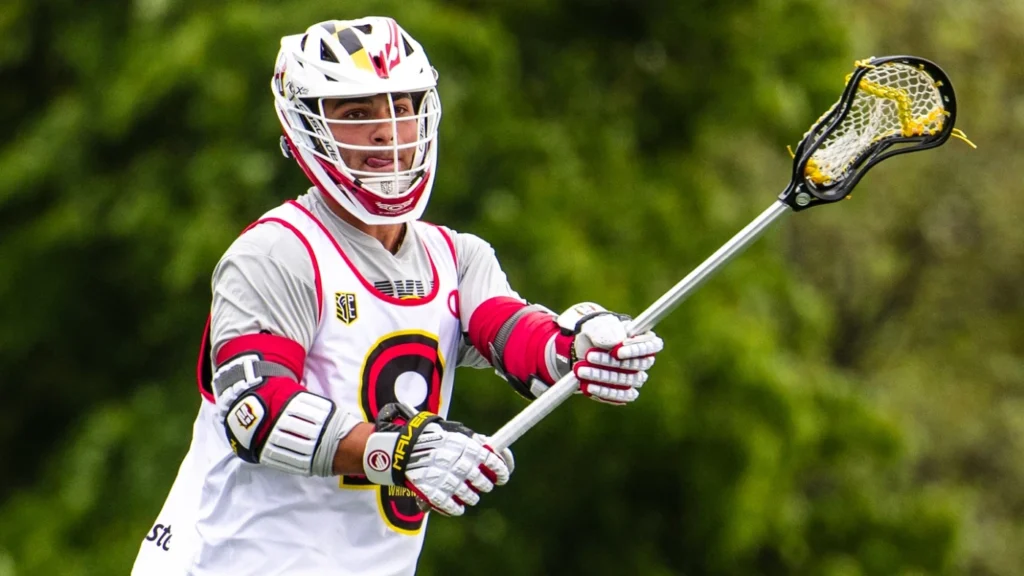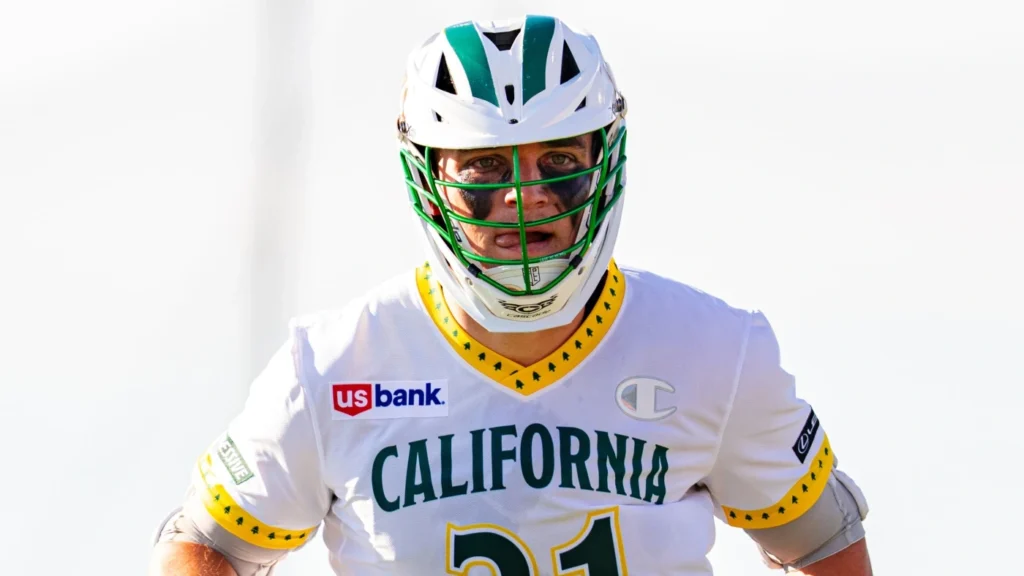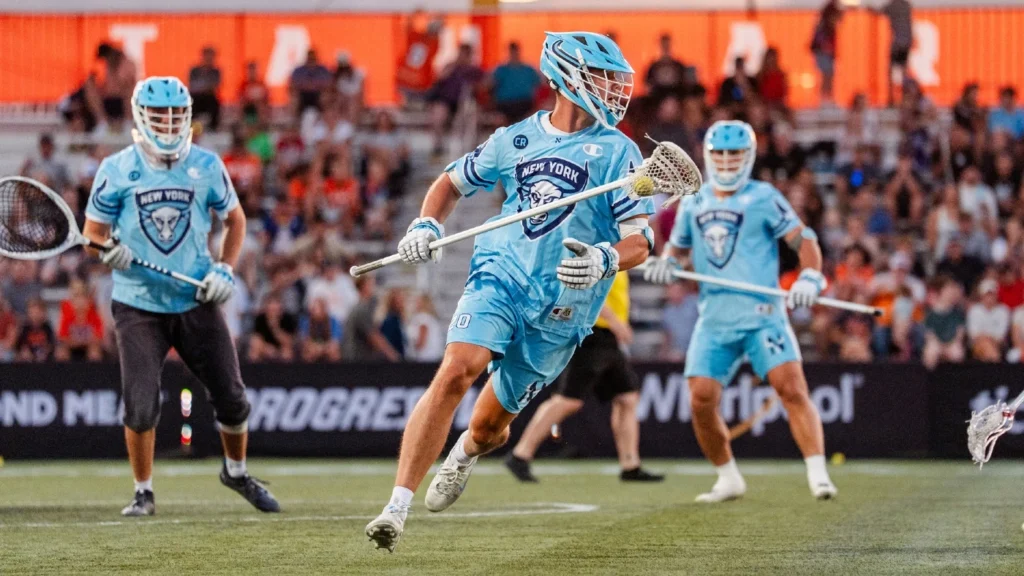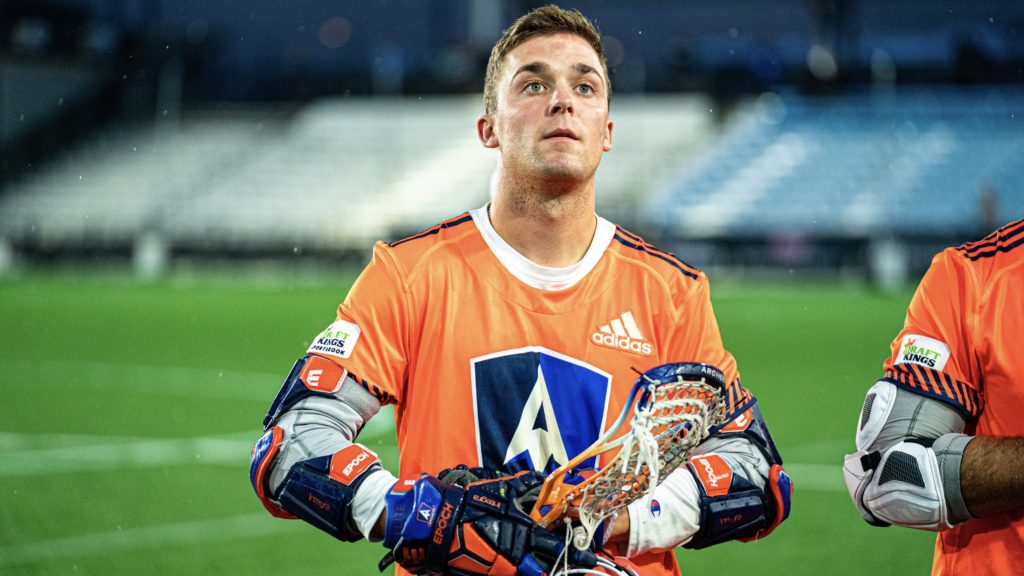
With past knee injuries healed, Connor Fields thrives in fresh start with Archers after offseason trade
By Andrew Crane | Aug 19, 2021
The newest piece of the Premier Lacrosse League’s most efficient offense inverted off to the right behind the cage, serving almost as a decoy. By the time the ball rotated to Connor Fields, tucked behind the Whipsnakes defense, he stared at three steps of space in front of him.
Fields began to cradle as overtime between the Archers and Whipsnakes on Aug. 15 reached its midway point. The play that head coach Chris Bates had called started with top midfielder Tom Schreiber’s dodge, which was done. Then came the pass through X, where it reached Fields — the new piece. And that triggered the final stage, the call to “go to the rack” as Fields said postgame, where he beat short-stick defensive midfielder Jake Bernhardt, planted his right leg, and flung a game-winning shot into twine.
Four years prior, Fields stood in similar positions at X inside Tom & Mary Casey Stadium, creating and then facilitating the Albany offense. The Great Danes’ gradual climb to the top of the Division-I rankings coincided with Fields’ emergence as its dynamic prospect, though he drew top cover defenders instead of short-stick matchups. He spent a year learning behind Lyle Thompson, finishing passes with precision skills taught by a box lacrosse upbringing and sponged as many dodging insights as he could, climbing into Thompson’s role his last three years and finishing with 364 points, the second-best career total in D-I history.
Those steps positioned him for moments like last Sunday: the center of celebration huddles, the recipient of three water-bottle pourings during a postgame interview, the little moments which fused into a single reminder that Fields still carried high potential. In between were the months of knee injuries, the plotted routes to a full recovery while still playing as much as possible, and finally the benching and trade from Chaos to the Archers after the 2020 season. He’d fallen out of the starting lineup, no longer trusted with the role he once had, and knew he needed a “switch up.” “It was best for both parties there,” Fields said.
The trade buried him on a depth chart filled with offensive names capable of carrying offenses in the PLL, though, and he had to work his way back up. Bates ran Fields out of the box while encouraging him to trust the ball in his stick and avoid passing up shots. The scoring opportunities wouldn’t be as plentiful as they were with Chaos — Fields finished second in the PLL in goals his first season — but Bates still needed him to convert. Heading into Saturday’s quarterfinal matchup against his former team, Fields has tallied 13 goals and 22 points, unlocking the full potential of his role in an offense that’s started to do the same.
“When he's used at full capacity,” Archers attack Grant Ament said, “he's one of the scariest players in the world.”
For almost a year, injuries prevented Fields from reaching a level like that. A nagging knee kept nagging during the pivotal transition between college and professional lacrosse, worsening with each game played on it. And the brace, even just the sight of it, reminded Fields about his knee. A lot. So much so that he stopped wearing it during the 2019 PLL season because every time he glanced down during a game, thoughts of injuries and surgeries and painful recoveries crept back into his mind.
CONNOR FIELDS WINS IT IN ALBANY! 🔥
— Premier Lacrosse League (@PremierLacrosse) August 15, 2021
The Great Dane alum seals the deal in OVERTIME at his Alma Mater! pic.twitter.com/iNCFoqxab3
In more than a year full of calculated risks related to ACLs and MCLs, this was just the latest one. It all started after a game against UMass Lowell on March 24, 2018, the eighth game of his senior year at Albany, when the Great Danes traveled to Cushing Field Complex, the turf became “dewey,” head coach Scott Marr said, and Fields slipped. He finished that game. It gave out the week after against Harvard too, but he couldn’t finish that one. Fields started to miss practices between Mondays and Thursdays to keep the swelling down, cycling through physical therapy and cryotherapy sessions all while hiding the true extent of the injury from anyone outside the nervous inner circle of family and coaches.
His brother, Peter, would flip on Fields’ games at Erie County Medical Center during his surgery rotation’s downtime and, along with his parents, anxiously await phone calls afterward to make sure that a pivot hadn’t locked his knee the wrong way, that the swelling hadn’t become too overpowering, that, in the day-to-day approach defining Fields’ senior year, he could he felt good enough to play in the next one.
“We were really concerned he was going to make things worse because once one ligament goes you risk cartilage damage,” Peter said. “And there's a lot of really bad things you can do to your knee.”
By the end of the regular season, Fields had sprained his MCL and torn his ACL. He missed one full game, and stayed on the sidelines for extended parts of others. A cortisone shot before the NCAA tournament helped spell pain during Albany’s run to Championship Weekend, with Fields, then a senior, at the forefront, but he was advised to not get surgery until three months after the cortisone injection.
That left Fields with a decision to make. The MLL’s Charlotte Hounds drafted him No. 3 overall following his senior season, and he decided to play through the MLL season — or at least until the knee flared once more — and reassess the idea for surgery afterward. Three games later, though, the knee gave out again, and Fields stopped playing before having surgery in August.
“I couldn't keep doing it,” Fields said. “It was painful, and mentally it was painful.”
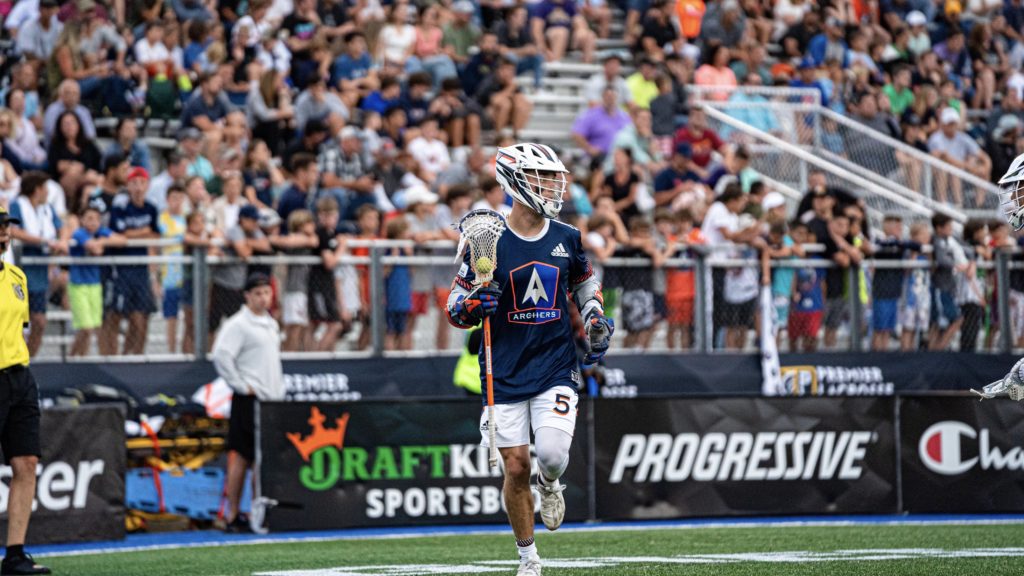
The injury threatened to undo the explosiveness of his dodging that Fields had honed in his backyard with Peter. They’d played a lacrosse version of Pig where they needed to call out their move — split dodge to the left with a bottom-right corner finish, for example — before starting. Then Fields would work on dodging from X, with Peter, an attackman in his lacrosse career, serving as a defender, because that’s the area Fields knew he needed the most improvement.
It was a lot of “trial and error,” he said. He tried the speedy approach, then the slower and change-of-pace one. Peter showed him how to jab, how to open up his hips, all the “tricks” that soon became part of Fields’ toolkit, too. One time, Fields’ father told him to aim for the defender’s hip since those shots were difficult for goalies to track. Peter strolled out as the defender, and Fields whipped the first shot directly off his hip. “It felt like he shattered my hip with his lacrosse stick,” Peter said, “so I was like ‘we're not doing that anymore.’”
Seasons of box lacrosse in Fort Erie, Ontario, as a child paved the strong shooting foundation Fields held as a college, and professional, prospect. He tagged along to Peter’s initial tryout when he was 6 or 7 years old, and snagged his older brother’s helmet and gloves — to go along with a stick much larger than him — to play wall-ball after the session concluded. He impressed Torrey Sowden, there to coach a younger age group, and he recognized that Fields threw the ball better than most of the kids on his team. Sowden asked Peter Fields, his father, why his youngest son hadn’t joined a team. “He’s too small,” he replied, but Sowden countered with “you can’t hit what you can’t catch” and arranged for Fields to join the next practice with equipment the right size.
Fields’ relationship with Sowden became a reference point as his development continued, far past their days of understanding the basics of cradling and shooting. When Sowden attended Albany’s games against Canisius and Syracuse, Fields’ father always introduced him to other fans as “the guy who got (Fields) where he is.” Sowden didn’t agree with that. All he did, he said, was introduce Fields to the game, and Fields did the rest — the learning, the experimenting with creativity — on his own.
Sowden jumped up and cheered from his family’s section, primarily rooting for another team, when Fields scored twice in his Major Lacrosse Series debut for the Oakville Rock in 2017. And when Fields and the San Diego Seals played the Buffalo Bandits to open his second NLL season, Sowden stood and yelled amid a pro-Bandits section when Fields scored. “Sit down,” everyone around his spot in the second row of KeyBank Center screamed.
“'No, this guy, he's a Buffalo native,’” Sowden jabbed back. “I ain't sitting down. I'm a Connor Fields fan.”
That 2019-20 season, sandwiched in between his two years with Chaos, was the first Fields truly felt comfortable playing on his right knee, he said. It wasn’t hectic like the last year, where he returned from surgery to play the playoff, flashed his potential for the Seals and then hoped to transfer it over to the PLL. This time, Fields finished fourth on the Seals with 44 before COVID-19 cut the season short.
He carried that success over to the PLL Championship Series, where he scored six goals for Chaos, but then came the turning point after a one-goal loss to the Waterdogs. Fields showed up to practice the next day and found out about a lineup switch in the locker room that left him on the bench, removing him from a lineup that made a run to the title game. He didn’t record a goal, or shot, for the rest of the year. Once the offseason arrived, Bates talked with Albany head coach Scott Marr and Chaos head coach Andy Towers before scheduling a Zoom with Fields to confirm his gut feeling that a trade would be the right fit. They started off with light talk, about Marr’s air-guitar before games or their musical tastes, before diving into how Fields could slot into Bates offense — the “chess” portion of the game — for the fresh start that he needed.
“I think his game's really gonna continue to blossom in our system, within our framework, and I think the future is bright,” Bates said in June, and it’s turned into a league-high 38% offensive efficiency during the regular season.
Connor Fields is a WIZARD 🧙♂️ @connorfields05 @PLLArchers pic.twitter.com/C8LGnjkNL8
— Premier Lacrosse League (@PremierLacrosse) July 4, 2021
Bates envisioned a player that could serve as a hybrid piece in his offense, from big-little sets to isolated dodges against short-sticks to floating off-ball and finding ways to pierce a defense. Fields started to mesh with the rest of the offensive group during the offseason by answering Bates’ ice-breaker questions on positional Zooms about favorite siblings (Peter) and favorite dog (Riley, his Husky), ordering Dairy Queen DoorDash with Ament in training camp, and explaining the origin story of his two Instagram post hashtags — #Cavsin7 and #Saucey — to Schreiber and others.
Mixed in was a mutual hope that all this could translate over to the field, that all the talented individual pieces could forge a dynamic group for eight regular-season weeks and more in the playoffs, maybe sacrificing the past roles they’ve all held along the way.
"That's a hard thing to do when you get traded and you're trying to write a new script and play well," Ament said.
For Fields, that revitalized potential exploded onto the surface as the first quarter wound down in the season-opener against the Atlas. Christian Mazzone flipped him the ball just outside the 2-point arc, giving Fields space and a winding clock to work with as he planted his brace-less right knee just outside the arc.
Fields doesn’t know where the brace is now, the one that he’d worn and then ripped off. It might be in the basement of his parent’s house. And that’s OK — it can stay there. From the arc at Gillette Stadium, with his brother in the stands, Fields ripped a 2-point shot that bounced into the cage and extended their lead to 6-2. Fields jogged back to the Archers sideline bobbing and holding two fingers, and from the other side of the field at the 30-yard-line, Peter could sense his younger brother’s relief.

